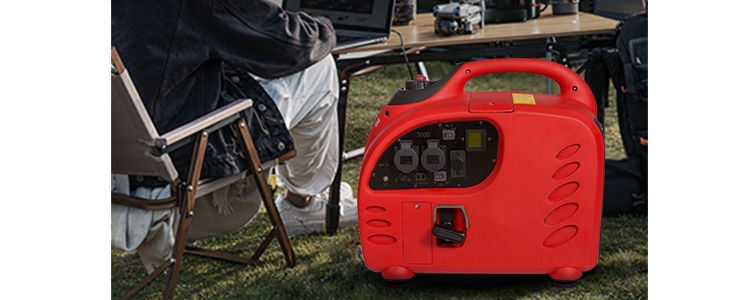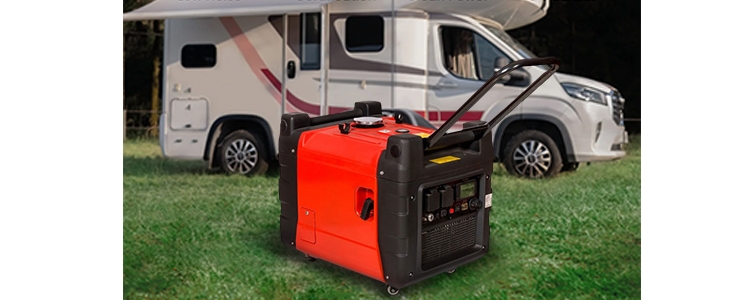The inverter generator, as a remarkable representation of modern power conversion technology, plays a critical role in portable power, outdoor operations, and home backup power. Its unique inverter technology not only delivers efficient and stable AC power but also achieves environmentally friendly features like low noise and emissions. Today, Home Power Inverter will provide a professional analysis of the working principles, key components, technical characteristics, and widespread applications of inverter generators, aiming to give readers a comprehensive and in-depth understanding.
What is an Inverter Generator?
As the name suggests, an inverter generator integrates inverter technology. It begins by using an internal combustion engine (such as a gasoline or diesel engine) to drive a generator that produces direct current (DC), which is then converted to alternating current (AC) through the inverter. The core of this process lies in the inverter, which converts unstable DC power into stable, pure AC power to meet the needs of various electrical devices.

How Does an Inverter Generator Work?
The inverter is the core component of an inverter generator, and its operation is based on the switching actions of power electronic devices such as IGBT and MOSFET. These devices rapidly switch states to control the direction and magnitude of the current, thereby converting DC to AC. Specifically, the working process of an inverter involves several key steps:
- DC Input: The inverter receives DC power from the generator, which may have some fluctuations and noise that need preprocessing through a filter circuit.
- Inversion Process: The inverter's core component is the inverter bridge, made up of multiple power electronic devices. By controlling the switching states of these devices, the bridge converts DC to AC. During this process, control logic precisely adjusts the switching frequency and duty cycle based on preset voltage and frequency parameters to produce stable AC output.
- Filtering and Voltage Regulation: The AC produced by the inverter often contains harmonics and noise, which are filtered out, and the voltage is stabilized through a regulation circuit to ensure the output meets the requirements of the load.
- AC Output: The filtered and regulated AC power is supplied to the load through the output circuit. The output waveform is typically a sine wave, providing high-quality power with low harmonic content.
Key Components of an Inverter Generator
An inverter generator mainly consists of the following parts:
1. Internal Combustion Engine: As the power source, the engine burns fuel to generate mechanical energy, driving the generator. The performance and efficiency of the engine directly affect the overall performance of the generator.
2. Generator: Converts the mechanical energy from the engine into DC power using components such as the stator and rotor, based on electromagnetic induction.
3. Inverter: As described earlier, the inverter (such as a pure sine wave inverter) converts DC to AC, ensuring a clean and stable output that is suitable for powering sensitive electronic equipment.
4. Control System: Monitors and regulates the operation of the generator, including engine speed, generator output voltage and current, and inverter switching states. Precise control strategies ensure stable and efficient operation.
5. Protection System: Monitors various parameters of the generator and takes protective measures, such as cutting power or other interventions in case of anomalies, preventing equipment damage or safety hazards.
Technical Characteristics of Inverter Generators
Compared to traditional generators, inverter generators offer several notable technical advantages:
1. High Efficiency and Energy Savings: By employing advanced inverter technology and efficient internal combustion engines, inverter generators achieve higher energy conversion efficiency. Additionally, their low noise and emissions meet modern environmental standards.
2. Stability and Reliability: With precise control strategies and advanced filtering techniques, inverter generators produce stable, pure AC power. Voltage and frequency fluctuations are minimal, making them suitable for powering sensitive electronic equipment.
3. Portability and Light Weight: Inverter generators are typically designed to be lightweight and compact, making them easy to carry and move. Their low noise levels also make them more comfortable to use outdoors.
4. Intelligent Control: Modern inverter generators are often equipped with intelligent control systems, enabling remote monitoring, fault diagnosis, and automatic protection. These features enhance reliability and safety while reducing maintenance costs and ease of use.

What are the Applications of Inverter Generators?
Due to their unique technical characteristics and broad application range, inverter generators have become an essential part of modern power conversion technology. Some key application areas include:
- Outdoor Operations: In fieldwork, exploration, camping, and other outdoor activities, inverter generators provide stable and reliable power to meet the electrical needs of various devices. The 2500W inverter generator for sale at Inverter.com has an LCD and a noise level of 65 decibels and is widely used in RVs, camping, computers, TVs, and radios.
- Home Backup Power: In emergencies such as natural disasters and power outages, inverter generators can serve as backup power for homes, providing electricity to household appliances.
- Industrial Production: In industrial settings, inverter generators are used for temporary power, equipment testing, and emergency repairs, ensuring smooth operations.
Vehicles: Inverter generators are widely used in vehicles such as ships and cars. For example, in electric vehicles, they can act as onboard chargers, while on ships, they provide power to electrical equipment. - Vehicles: Inverter generators are widely used in vehicles such as ships and cars. For example, in electric vehicles, they can act as onboard chargers, while on ships, they provide power to electrical equipment.
- Renewable Energy Systems: With the rapid development of renewable energy, inverter generators are increasingly used in solar and wind power systems. By converting these renewable sources into stable AC power, they support grid integration and distributed energy systems.
As a prominent representation of modern power conversion technology, inverter generators play a vital role across multiple sectors due to their efficiency, reliability, portability, and intelligent control features. With ongoing technological advancements and the rapid growth of renewable energy, the application potential of inverter generators will continue to expand. Inverter Online Store believes that in the future, as technologies like the Internet of Things and artificial intelligence are further integrated, inverter generators will achieve even greater intelligence, adaptability, and remote monitoring capabilities, bringing more convenience and security to everyday life and work.
